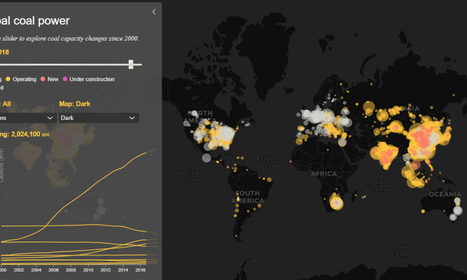 Your new post is loading...
 Your new post is loading...
International Children's Digital Library
You could pay $118 on Amazon for 'The Art of Illumination.' Or you could pay $0 to download it at MetPublications,
Print or order free materials about Child Development.
Free resources for pediatric occupational therapy activities; free OT worksheets, handouts, and occupational therapy interventions for special education.
ICT, eLearning, Digital Technologies and Computer Science Ideas, REsources, Thinkiing
Book info on 'Which Shoes Do You Choose?' told by Aaron Shepard, illustrated by Wendy Edelson.
The leading campaign against plastic pollution – including facts about plastic and the environment, and how to avoid single-use plastics.
Today’s interactive map shows all of the world's coal power plants, plotted by capacity and carbon emissions from 2000 until 2018.
Find educational resources for Grades Pre-K–12, from brief activity ideas to rich multimedia lessons and units.
From chemistry to computer programming, arts to World War II, ThoughtCo.com provides guides, tips, and resources to help you understand more about the world around us.
The Free On-line Dictionary of Computing contains terms from computing such as acronyms, jargon, programming languages, tools, architecture, operating systems, networking, theory, conventions, standards, mathematics, telecoms, electronics, institutions, companies, projects, products and history of computing.
|
Count nouns use singular and plural verbs and pronouns: There is an apple. Noncount nouns use only singular verbs and pronouns: There is some fruit.
AFIRM Modules AFIRM Modules are designed to help you learn the step-by-step process of planning for, using, and monitoring an EBP with learners with autism from birth to 22 years of age. Supplemental materials and handouts are available for download. Download an overview of the Components of AFIRM to learn about modules, resources, and professional development options. Visit
Activities for children of all ages to look at, talk about and make their own discoveries about art. As you explore this resource please keep in mind that there are no wrong answers, or that there is only one way to do the activities - they are all about looking
Free resources for pediatric occupational therapy activities; free OT worksheets, handouts, and occupational therapy interventions for special education.
My NASA Data is one of the few NASA Earth Science educator resources providing grade 3-12 teachers access to NASA mission data through unique tools that help students learn about Earth system science.
Bring professional development events to life with challenges that merge collaboration, interactivity, and problem-solving in a hands-on environment for learning technology.
Explore our National Geographic Kids’ primary resources, for fun and exciting teaching ideas and pupil-focused resource sheets aligned with the Curriculum
See the countries with the most oil reserves on this map, which resizes each country based on how many barrels of oil are contained in its borders.
137
Owlcation»Social Sciences»Political Science
The 8 Main Reasons for War
Updated on February 5, 2019
Paul Goodman more
U.K.-born Paul has worked as a librarian and bookseller since graduating from university. He now works as a freelance writer in Florida.
Contact Author
American soldiers on the move. Up until the late 19th century, wars used to be fought almost exclusively as a series of set piece battles. Modern technology and other trends, such as asymmetric warfare have changed how wars are fought.
What Is a War?
A war is typically fought by a country or group of countries against an opposing country with the aim of achieving an objective through the use of force. Wars can also be fought within a country in the form of a civil or revolutionary war.
According to the Oxford English Dictionary, "war" is defined as
A state of armed conflict between different countries or different groups within a country.
A state of competition or hostility between different people or groups.
A sustained campaign against an undesirable situation or activity.
Wars have been a part of human history for thousands of years, and have become increasingly destructive as industrialization and technology have advanced.
What Is the Cause of Conflict?
There is rarely one single, clear cause of conflict and, ultimately, war. The causes of a war are usually numerous, and several reasons for a conflict can be intertwined in a complicated way.
Many theories have been put forth over the years as to why wars happen, and some of the greatest minds have offered their take on the subject.
In the article below, I'll provide a general overview of the eight main reasons for war.
Eight Main Causes of War
Economic Gain
Territorial Gain
Religion
Nationalism
Revenge
Civil War
Revolutionary War
Defensive War
Continue reading for more information on each of these reasons for war.
1. Economic Gain
Often wars are caused by one country's wish to take control of another country's wealth. Whatever the other reasons for a war may be, there is almost always an economic motive underlying most conflicts, even if the stated aim of the war is presented to the public as something more noble.
In pre-industrial times, the gains desired by a warring country might be precious materials such as gold and silver, or livestock such as cattle and horses.
In modern times, the resources that are hoped to be gained from war take the form of things like oil, minerals, or materials used in manufacturing.
Some scientists believe that as the world’s population increases and basic resources become scarce, wars will be fought more often over fundamental essentials, such as water and food.
Historical Examples of Wars Fought for Economic Gain
Anglo-Indian Wars (1766-1849) – The Anglo-Indian wars were a series of wars fought between the British East India Company and different Indian states. These wars led to the establishment of British colonial rule in India, which gave Britain unrestricted access to exotic and valuable resources native to the Indian continent.
Finnish-Soviet War or "The Winter War" (1939-1940) – Stalin and his Soviet Army wanted to mine Nickel and Finland, but when the Finnish refused, the Soviet Union waged war on the country.
A strategic map of central Europe from 1917. | Source
2. Territorial Gain
A country might decide that it needs more land, either for living space, agricultural use, or other purposes. Territory can also be used as “buffer zones” between two hostile enemies.
Related to buffer zones are proxy wars. These are conflicts that are fought indirectly between opposing powers in a third country. Each power supports the side which best suits their logistical, military, and economic interests.
Proxy wars were particularly common during the Cold War.
Historical Examples of Wars Fought for Territorial Gain
Mexican-American War (1846-1848) – This war was fought following the annexation of Texas, with Mexico still claiming the land as their own. The U.S. outfought the Mexicans, retaining Texas and incorporating it as a state.
Serbo-Bulgarian War (1885-1886) – Bulgaria and Serbia fought over a small border town after the river creating the border between the countries moved.
Arab-Israeli War or "Six Day War" (1967-1988) – Israeli forces took the territories of the West Bank, including East Jerusalem, from Jordan.
3. Religion
Religious conflicts often have very deep roots. They can lie dormant for decades, only to re-emerge in a flash at a later date.
Religious wars can often be tied to other reasons for conflict, such as nationalism or revenge for a perceived historical slight in the past.
While different religions fighting against each other can be a cause of war, different sects within a religion (for example, Protestant and Catholic, or Sunni and Shiite) battling against one another can also instigate war.
Historical Examples of Wars Fought for Religion
The Crusades (1095-1291) – The Crusades were a series wars sanctioned by the Latin Church during the medieval age. The aim of crusaders was to expel Islam and spread Christianity.
Thirty Years' War (1618-1648) – When Holy Roman Emperor Ferdinand II tried to impose Roman Catholicism on the people of his domains, a faction of Protestants from the north banded together, sparking war.
Lebanese Civil War (1975-1990) – The Lebanese Civil War was primarily sparked from conflicts between the Sunni Muslim, Shiite Muslim and Christian Lebanese populations.
Yugoslav Wars (1991-1995) – The Yugoslav wars consisted of the Croatian War and the Bosnian War. The wars were fought between the orthodox Catholic and Muslim populations of former Yugoslavia.
Second Sudanese Civil War (1983-2005) – This ethnoreligious war was caused by the Muslim central government's choice to impose sharia law on non-muslim southerners.
Russian soldiers in ceremonial uniforms. Most military groups have traditions, customs, special dress and awards that provide soldiers with recognition within a wider cultural framework. | Source
4. Nationalism
Nationalism in this context essentially means attempting to prove that your country is superior to another by violent subjugation. This often takes the form of an invasion.
Dr. Richard Ned Lebow, Professor of International Political Theory at the Department of War Studies, Kings College London, contends that while other causes of war may be present, nationalism, or spirit, is nearly always a factor. In his essay "Most wars are not fought for reasons of security or material interests, but instead reflect a nation's spirit," he writes:
"[Literature on war and its causes] assumes security is the principal motive of states and insecurity the major cause of war. Following Plato and Aristotle, I posit spirit, appetite and reason as fundamental drives with distinct goals. There can be little doubt that the spirit is the principal cause of war across the centuries."
Related to nationalism is imperialism, which is built on the idea that conquering other countries is glorious and brings honor and esteem to the conqueror.
Racism can also be linked to nationalism, as can be seen in Hitler’s Germany. Adolf Hitler went to war with Russia partly because the Russians (and eastern Europeans in general) were seen as Slavs, or a group of people who the Nazis believed to be an inferior race.
Historical Examples of Wars Fought for Nationalism
Chichimeca War (1550-1590) – The Chichimeca war was one of many wars fought during the Spanish conquest of the Aztec civilization in modern day Mexico.
World War I (1914-1918) – Extreme loyalty and patriotism caused many countries to become involved in the first world war. Many pre-war Europeans believed in the cultural, economic and military supremacy of their nation.
5. Revenge
Seeking to punish, redress a grievance, or simply strike back for a perceived slight can often be a factor in the waging of war. Revenge also relates to nationalism, as the people of a country which has been wronged are motivated to fight back by pride and spirit.
Unfortunately, this can lead to an endless chain of retaliatory wars being set in motion which is very difficult to stop.
Historically, revenge has been a factor in many European wars,
Historical Examples of Wars Fought for Revenge
World War II (1939-1945) – The rise of the Nazi Socialist Party and Germany's eventual domination of the European continent were direct results of the Treaty of Versailles, which imposed strict punishments on Germany.
War on Terror – The September 11th attacks on the World Trade Center in 2001 prompted President George W. Bush to initiate a war on terror. This global war began with an invasion of Iraq and is ongoing.
African American soldiers fighting in the American Civil War. The American Civil War saw the first signs of mechanized warfare, which would become more apparent with the onset of World War I later in Europe. | Source
6. Civil War
These generally take place when there is sharp internal disagreement within a country. The disagreement can be about who rules, how the country should be run or the people's rights. These internal rifts often turn into chasms that result in violent conflict between two or more opposing groups.
Civil wars can also be sparked by separatist groups who want to form their own, independent country, or, as in the case of the American Civil War, states wanting to secede from a larger union.
Historical Examples of Civil Wars
American Civil War (1861-1865) - The American Civil War was fought by the Union army and the Confederate army as a result of the long-standing controversy over slavery.
Russian Civil War (1917-1923) – The Russian Civil War followed immediately after the Russian Revolution, with the Red Army and the White Army vying to determine Russia's political future.
Spanish Civil War (1936-1939) – The Spanish Civil War was fought between the Republicans, who were loyal to the left-leaning Second Spanish Republic, and the Nationalists, a largely aristocratic conservative group led by General Francisco Franco.
Korean War (1950-1953) – The Korean War was a war fought between North Korea, which was supported by China, and South Korea, which was supported primarily by the United States.
7. Revolutionary War
These occur when a large section of the population of a country revolts against the individual or group that rules the country because they are dissatisfied with their leadership.
Revolutions can begin for a variety of reasons, including economic hardship amongst certain sections of the population or perceived injustices committed by the ruling group. Other factors can contribute too, such as unpopular wars with other countries.
Revolutionary wars can easily descend into civil wars.
Historical Examples of Revolutionary Wars
Portuguese Restoration War (1640-1668) – The Portuguese revolution ended the 60-year rule of Portugal by Spain.
American Revolution (1775-1783) – The American Revolution gave the 13 North American colonies independence from British rule and established the United States of America.
French Revolution (1789-1799) – The French Revolution was a battle that represented the rise of the bourgeoisie and the downfall of the aristocracy in France.
Haitian Revolution (1791-1804) – The Haitian Revolution was a successful slave rebellion that established Haiti as the first free black republic.
8. Defensive War
In the modern world, where military aggression is more widely questioned, countries will often argue that they are fighting in a purely defensive capacity against an aggressor, or potential aggressor, and that their war is therefore a “just” war.
These defensive wars can be especially controversial when they are launched preemptively, the argument essentially being that: “We are attacking them before they inevitably attack us.”
Historical Examples of Defensive Wars
Cold War (1947-1991) – Many of the maneuvers during the Cold War can be seen as defensive or preemptive. One specific example is the failed Bay of Pigs invasion, when U.S. forces attempted to invade Cuba in order to prevent the establishment of nuclear warheads there.
QUESTIONS & ANSWERS
Question:What causes war?
Answer:
There is a multitude of causes of war, and they can only be learned through an extensive study of human history. Usually, but not always, it starts with a dispute between countries, or groups within a country, which subsequently becomes violent.
Helpful 142
Question:Why do some people believe that war is a good thing?
Answer:
In the modern age, people rarely think that war is good, but often they can see it as necessary. Examples of a necessary war might be defending your country against foreign invasion, or fighting a revolution against an unjust government.
Helpful 102
Question:What were the causes of the Napoleonic wars?
Answer:
The roots of the Napoleonic wars lie in the French Revolution. Napoleon seized power from the revolutionary government and attempted to stabilize a country that had suffered from years of chaos and excess. There were also numerous conflicts associated with the revolution and in an attempt to resolve these, Napoleon ended up fighting the other major European powers, especially the United Kingdom. It's difficult to know exactly what Napoleon's original intentions were, but eventually, the wars became a struggle to be the dominant power in Europe.
Helpful 67
Question:Who started war?
Answer:
Nobody knows for sure. What we do know is that the first recorded war was between Sumer and Elam in Mesopotamia in 2700 BCE. The Sumerians won, it is recorded, and they: “carried away as spoils the weapons of Elam.” However, archaeology suggests that warfare was taking place much earlier in the Mesopotania/Egypt area, quite possibly as early as 10,000 BCE.
Helpful 58
Question:Can violence ever solve conflicts?
Answer:
It really depends what you mean by "solve". What is true is that periods of violent conflict can be followed by extended periods of peace. If the source of a conflict doesn't go away, however, there is every possibility that the conflict will erupt again, violently or otherwise. As human technology has advanced and warfare has become increasingly destructive, there has been an increased urgency to resolve conflicts non-violently.
Get free K-12 video lessons; mobile apps; audiobooks, ebooks and textbooks; foreign language lessons; test prep materials; and web resources for kids!
Webopedia is an online dictionary and Internet search engine for information technology and computing definitions. Voted Best Technology Website.
|



 Your new post is loading...
Your new post is loading...





















